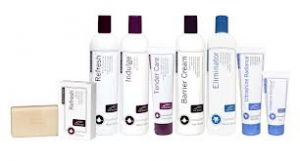When our daughter was born in 2005, we noticed that her Johnson & Johnson baby shampoo, ‘aptly’ decorated with soft Teddy bears, contained SLS (Sodium Laureth Sulphate) together with many other chemicals. SLS is a foaming agent and degreases by stripping down proteins. That is why is an irritant to eyes and skin is. Has a complex, but small molecule [CH3(CH2)10CH2(OCH2CH2)nOSO3Na], and can easily penetrate through skin and mouth membranes, as it is also in every mainstream toothpaste. Since the body cannot break it down, it also accumulates in the human tissue. A discovery that frightened and infuriated me at the same time. I called the J&J Headquarters and was passed on to the Public Relation department. I had one question; “Why do you use SLS in baby shampoo if you know what it does?” After 20 min of grilling and being transferred from one PR officer to another, one of them snapped and said: “Because it works, it’s cheap and we are allowed to!” I was stupefied. I hung up, as I simply had nothing more to say. The spokesperson summed it perfectly – if it’s cheap, it works and it’s allowed – they will use it. Then I rang ACCC, then ACIC, then TCA and then CSIRO, looking for any government organisation responsible for the control of the substances and ingredients for personal care products. There was none that was doing that.
 Nevertheless, the consumer has the power of choice and it’s up to them to apply conscientiously their intelligence and consumer knowledge to their choices. Majority of people are ignorant, so they keep on buying it. If you think a government regulation or standard will protect you form this, you are sorely mistaken. They would not act unless there is a definitive study that proves that any substance is harmful, but they would not test it themselves. Who else is left then? It is left to the manufacturer to submit the test results. Not likely to be tested long enough to find out if it is safe for man, women, children of all ages and what is the effect on the membranes, nervous, endocrinal, reproductive systems etc. Even so, it would take at least a decade or two to remove it. Do you honestly believe that a Corporation would invest millions on a research on an ingredient that will conclude that is harmful. It would cost them tens of millions in lost profit to recall and restructure production and much more in potential lawsuits. Car manufacturers do it, as it would cost lives and bad reputation that they cannot afford. Personal care manufacturers can getaway with it, because it is not that obvious and the unsuspected consumer hasn’t got a clue why it got very sick all of a sudden.
Nevertheless, the consumer has the power of choice and it’s up to them to apply conscientiously their intelligence and consumer knowledge to their choices. Majority of people are ignorant, so they keep on buying it. If you think a government regulation or standard will protect you form this, you are sorely mistaken. They would not act unless there is a definitive study that proves that any substance is harmful, but they would not test it themselves. Who else is left then? It is left to the manufacturer to submit the test results. Not likely to be tested long enough to find out if it is safe for man, women, children of all ages and what is the effect on the membranes, nervous, endocrinal, reproductive systems etc. Even so, it would take at least a decade or two to remove it. Do you honestly believe that a Corporation would invest millions on a research on an ingredient that will conclude that is harmful. It would cost them tens of millions in lost profit to recall and restructure production and much more in potential lawsuits. Car manufacturers do it, as it would cost lives and bad reputation that they cannot afford. Personal care manufacturers can getaway with it, because it is not that obvious and the unsuspected consumer hasn’t got a clue why it got very sick all of a sudden.
Remember the worldwide tobacco/nicotine scandal? Or the asbestos scandal? We believe that in the not so distant future, there will be lawyers firms signing of people on the streets for class action against the manufacturers of those unethical products. High Courts judges will be asking those company executives(if still alive): “When exactly did you know that this is harming people”. Meanwhile how many people will not be among us any more to prove the point?
If you are reading this, make your conscious choice for you and those ones that you are still responsible.
